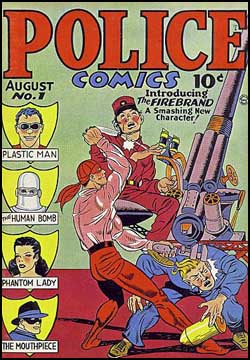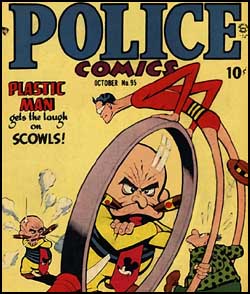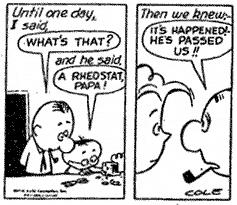|
Jack
Cole: A Life in Four Colors
(originally published in the Winter
1991 issue of Once Upon A Dime)
A
comics giant with an amazing ability, Jack Cole
was one of those virtuosos who could do vastly different
styles. He might have three different fanbases.
One loves all his voluptuous incredibly sexy women
in Playboy, done in water colors and oils. He did
a newspaper strip that was minimalist like Peanuts
called “Betsy and Me”, a droll domestic
situation comedy.
And
of course, he did Plastic Man, which marked
the dawn of a completely different style in comics.
He found incredible inventive ways to use Plastic
Man’s body.
 Yet
Cole in his bio would say “I worked for 11
years in comic books” never even mentioning
his most famous creation: Plastic Man. It’s
astonishing. Yet
Cole in his bio would say “I worked for 11
years in comic books” never even mentioning
his most famous creation: Plastic Man. It’s
astonishing.
In
those early days comic books were just a stepping
stone to get a real job. The holy grail was to get
your own newspaper strip. Other than that you could
hope to work in advertising or be a commercial artist
but you didn’t want to be known as a comic
book artist. You were thought of as one step above
pornographer. Ironically, it was none other than
Hugh Hefner who gave him work at a time when he
was trying to get out of comic books.
But
let’s take a look at those eleven years Cole
himself tended to gloss over.
In
the late 1930’s Detective Picture Stories
became Keen Detective Funnies as part of
the new Centaur Publications. Among the illustrated
detective heroes was TNT Todd of the FBI and Little
Dynamite drawn by Jack Cole. Centaur at the time
employed nearly every great name in Golden Age comics;
Seigel and Schuster, Bob Kane, Will Eisner, Bill
Everett, and Carl Burgos to name just a few.
In
1939 Silver Streak Comics hired Cole as editor.
There he wrote and drew the high speed adventures
of their titular character in addition to drawing
Daredevil (no relation to Matt Murdock).
That
same year MLJ’s Pep Comics offered
the world Archie Andrews and friends positioned
oddly alongside the first super patriot The Sheild.
But Pep had another costumed avenger, Jack
Cole’s The Comet. Jack worked on only the
first eight issues.
In
1941 the Comet was killed by his gangster foe Big
Boy Malone. This was perhaps the first case of a
superhero being killed off. The Comet was replaced
by his brother, the ominous Hangman, an even stranger
neighbor for Betty and Veronica.
1941
was a big year in the career of Jack Cole. In January
The Ray was the biggest hero at Quality Comics’
Smash Comics until in issue #18 Jack Cole’s
created a masked crime fighter named Midnight. Wearing
a fedora and a domino mask, Midnight had a slight
similarity to Eisner’s
Spirit in addition to sharing a debt to the
visual language of film. Cole’s bold cinematic
style employed unconventional “camera”
angles to frame the action in more compelling ways.
 By
the summer of that same year (1941) Cole was working
on his most famous character, Plastic Man. A highly
unusual hero character, “Eel” O’Brien
was a crook before gaining his super powers and
changing his views on crime. Plas joined The Firebrand,
The Human Bomb, The Mouthpiece and the Phantom Lady
in Police Comics #1 from Quality Comics.
Despite being given only six pages in which to convey
both the origin tale and the first caper, Plas grew
popular enough to appear on covers starting with
issue #5 and by issue #9 he had top billing. By
the summer of that same year (1941) Cole was working
on his most famous character, Plastic Man. A highly
unusual hero character, “Eel” O’Brien
was a crook before gaining his super powers and
changing his views on crime. Plas joined The Firebrand,
The Human Bomb, The Mouthpiece and the Phantom Lady
in Police Comics #1 from Quality Comics.
Despite being given only six pages in which to convey
both the origin tale and the first caper, Plas grew
popular enough to appear on covers starting with
issue #5 and by issue #9 he had top billing.
The
surreal nature of an elastic man meant Cole’s
art could be more inventive than comics readers
had seen before. There was a newness, a freshness
and modern quality to Plastic Man that few characters
from the era could match.
Cole
had a very whimsical style. A comedic, limber athletic
style that has been assimilated into other artists’
drawing style so gradually that we forget how unique
it was. The comic aspects of Cole and his character
also resonated with readers. Plas was an extension
(forgive the pun) of Cole’s humor. He would
bend the rules of comics as easily as Plas would
bend his limbs.
Just
as Cole’s creation Midnight had competed with
Eisner’s Spirit, now the Spirit would haunt
Cole’s new hero. In Police Comics #11
Plastic Man had to compete for space with Eisner’s
fedoraed fighter of felons. This must have been
an odd turn for Cole since he had once served as
Eisner’s assistant.
1941
also saw the huge success of Blackhawk in Military
Comics. Cole was brought in to write and illustrate
three issues of Death Patrol for the publisher.
The tale of a handful of felons turned Royal Airforce
Pilots concluded each month with one of them dying.
In 1947
when the tide in comics had turned toward Crime
Stories, Jack Cole was tapped by Magazine Village
to lead the design of their True Crime Comics. Cole
enlisted Alex Kotzky (who would later create Apartment
3G) and together they produced dark violent tales
including Cole’s sexy noir classic “Murder,
Morphine and Me!”
 In
1958 Cole had grasped the holy grail of comics artists;
his own newspaper strip “Betsy & Me”.
Yet despite that, this year would be his last. Jack
Cole wrote a letter to Hugh Hefner and one to his
wife, then put a gun in his mouth, commiting suicide. In
1958 Cole had grasped the holy grail of comics artists;
his own newspaper strip “Betsy & Me”.
Yet despite that, this year would be his last. Jack
Cole wrote a letter to Hugh Hefner and one to his
wife, then put a gun in his mouth, commiting suicide.
No
one could understand why.
Hefner
has intimated to me that the couple was childless
and there were problems in that area. But Cole wasn’t
a drinker or a wild guy. He was a mild mannered
gentle person. Everybody was stunned.
Jack
Cole and his work live on with fans like me (and
you?).
--
Donald Swan

|